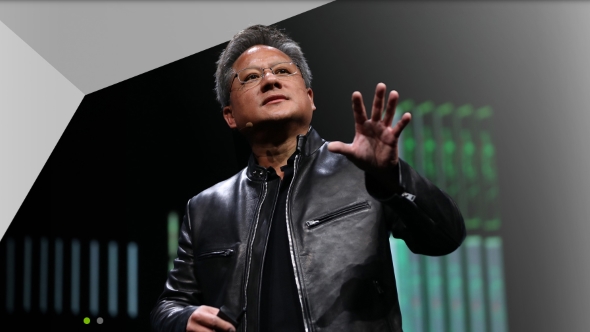- NVDA shares dropped 8% today on the announcement they temporary stopped autonomous testing and market sell off.
- While the company did not comment on timing, we expect testing to resume in the next 3 months.
- CEO Jensen Huang held a keynote today. The message was more GPU’s save money.
- The company announced 5 new products targeted at AI, autonomy, and VR.
Nvidia started its GPU Technology Conference on Monday with their focus on AI & Deep Learning. On Tuesday, CEO Jensen Huang gave a keynote on Nvidia’s latest developments in a few key product categories, but Nvidia’s stock dropped by 8%. We attribute 2/3 of the decline to the company announcing they’ve temporary stopped autonomous vehicle testing until they receive a diagnostic report from the Uber accident last week, and 1/3 from the broader tech sell off.

Buy more GPUs, save more money. The message from Jensen Huang was if you buy Nvidia’s GPUs, you can save money. The idea is using an Nvidia architecture requires less hardware that consumes less energy. That said, users of these systems are solving more advanced problems like AI, which will require an increase in total spending. We remain comfortable with our Nvidia revenue growth estimates of 31% in CY18 and 21% in CY19.
New Products. Nvidia made product announcements today:
- RTX (AI and blockchain). On the workstation front, the company announced the Quadro GV100 with (real-time ray tracing) RTX Technology. The RTX technology offers a measurable improvement in rendering times.
- DGX-2 (AI and blockchain). Nvidia also announced the DGX-2 platform for AI. The DGX-2 claims to be the first to offer 2 Petaflop single server deep learning system. Nvidia compared this platform to a traditional hyperscale center, which would have 300 dual-core CPUs and cost about $3M. The DGX-2 is may seem expensive at $399K, but it takes up 1/60th of the space and consumers 1/18th of the power.
- Isaac SDK (AI) Adding artificial intelligence to robots for perception, navigation, and manipulation. Nvidia showed a video of one of its first Isaac projects, a two-wheeled delivery robot named Carter.
- Drive Orin (Autonomy). Drive Orin is comparable to two Drive Pegasus supercomputers while being smaller in physical size. Jensen shared that many customers were including two Drive Pegasus chips in each vehicle, and it made sense to package the same computing power into one product.
- Drive Constellation (Autonomy). This is a datacenter solution used to test and validate self-driving vehicles in virtual reality.
- Project Wakanda (VR). See details below.
Nvidia committed to an autonomous future. Given the Tempe accident, Jensen spent most of the self-driving segment of the keynote talking about the importance of safety, and why fully-autonomous future means safer transportation. He also reiterated this his belief that self-driving cars are “probably the hardest computing problem that the world has ever encountered”. The company did not give a timeline of when testing will resume, but given the hold is based on the Uber review, we would expect it to take a few months. Autonomous simulation will play an increasingly important role in the future. Drive Constellation can run thousands of virtual worlds, each while running thousands of scenarios in order to collect more data. For example, 10,000 constellations can simulate about 3 billion miles in a year, significantly more than 5-10 millions driven each year by the current fleets of test vehicles.
Project Wakanda hints at the future of relationship between man and machine. Nvidia closed the keynote by unveiling what has been dubbed “Project Wakanda.” Similar to what we saw in Black Panther, Jensen showed a driver operating a vehicle in virtual reality, while sitting in a fully-equipped cockpit. Next, a third screen appeared and showed a driverless car at a remote location.

While Nvidia didn’t share much about its direction with this project, Jensen did share that he views virtual reality as a way to provide humans with teleportation – augmented with autonomous machines.
Disclaimer: We actively write about the themes in which we invest: artificial intelligence, robotics, virtual reality, and augmented reality. From time to time, we will write about companies that are in our portfolio. Content on this site including opinions on specific themes in technology, market estimates, and estimates and commentary regarding publicly traded or private companies is not intended for use in making investment decisions. We hold no obligation to update any of our projections. We express no warranties about any estimates or opinions we make.